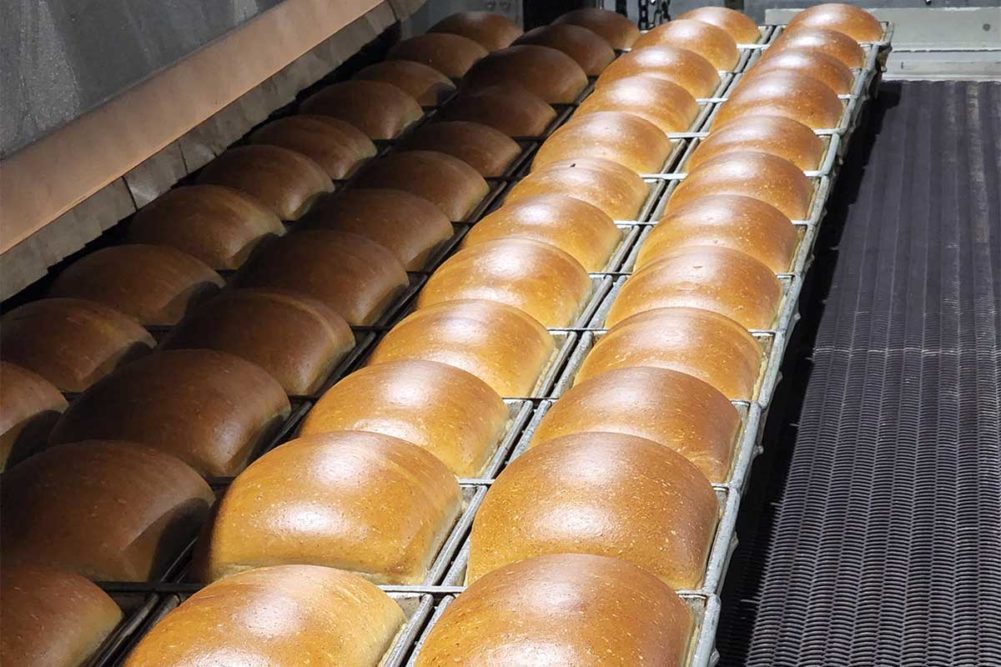The Good Bread Co., Taylor, Mich., tripled its sales across the past three years even with a dip in early 2020 due to the COVID-19 pandemic. That level of growth requires an investment in equipment and automated processes. In 2019, the bakery invested in two Koenig makeup lines, but the rest of the process was done in batches, with bowls of dough being given floor time for fermentation and racks pushed around between proofer, retarder and ovens. Racks and wagons littered the plant floor, while bread dough rested or baked product cooled.
Today, with one tunnel oven installed and another ready to assemble, The Good Bread Co. will have the infrastructure in place to reap the benefits of a more automated, continuous process.
This shift to a continuous process, however, has come with mechanical challenges as well as new processes and a culture shift. It was fairly simple to integrate the upstream process — specifically makeup — into the rebuilt Gemini Bakery Equipment/W&P tunnel oven. The Koenig lines are designed to run continuously and are more efficient and produce a higher, more consistent quality product when they do.
However, synchronizing the upgraded production line has made the startup a challenge.
“Usually when a baker installs a tunnel oven, it’s difficult to get the bake right,” said Spiros Assimacopoulos, chief executive officer. “Results from our first bake were excellent. We couldn’t have been more pleased. For us the challenge has been integration of the loading and unloading of the oven.”
The tunnel oven has completely changed the way The Good Bread Co. approaches production planning as well. What a batch process gains in flexibility — the ability to meet every customer’s whim with small runs of different products — it loses in efficiency and throughput. This can also have an impact on the product’s consistency. A continuous process, however, loses that flexibility in favor of long consolidated product runs with high volumes.
For example, in The Good Bread Co.’s batch process, the East Bakery can produce 9,000 lbs a day of its 3-lb artisan loaf. The expanded baking capacity of the tunnel oven removes this bottleneck and can produce 45,000 lbs of that SKU per day, finishing production on that product for an entire week. It eliminates not only four changeovers in one day but also six handling touchpoints.
“We have to plan our production now so that we can run the same product for 8 to 16 hours to gain efficiencies and consistency,” Mr. Assimacopoulos said. “Reducing operational complexity is a constant challenge.”
Being able to bake so much product at one time unlocks the capabilities of the three Koenig makeup lines and the new tunnel oven, but it also means the bakery has to be tuned into all of its surrounding processes — such as cooling times — as well as the schedule it needs to fill. In the batch process, if the bakery was slightly off on filling an order or a last-minute order came in, it wasn’t difficult to run an extra batch to address any misses. With a continuous process, squeezing in a small batch isn’t in the best interest of production, so the bakery must stay on schedule for the week. The Good Bread Co. sees the need for an ERP system and data collection to really zero in on customer orders and operational efficiencies.
This shift always requires a change in culture, specifically recognizing the impact of downtime. In a batch process, when equipment goes down or bread needs more time to proof or cool, it’s a minor ripple in the product flow. With a tunnel oven turning out 20 pans per minute, it’s a tsunami when something goes wrong.
“We are working to develop a pit crew mentality when line stoppages occur,” Mr. Assimacopoulos said. “This is big change for the team accustomed to batch baking.”
The automation in the facility also is aimed at providing The Good Bread Co.’s employees with more opportunity. During Baking & Snack’s tour, Mr. Assimacopoulos pointed out an employee who was loading pans onto the conveyor to receive freshly moulded whole grain bun dough pieces.
“This activity is critical to running the line but is not valued added,” he said. “This team member has much more to offer than placing pans on a belt. When we have a conveyorized proofer, we’ll be able to develop positions that are less physically demanding and add more value to the process. We’re removing repetitive manual labor in favor of positions that require more technical skills.”
While Mr. Assimacopoulos said they have tried traditional strategies like recruiters for high-level positions, he has had the most luck relying on word-of-mouth and referrals from his best employees.
“The way we treat each other has put us in a position where great employees are calling their friends to come work here,” he said.
Between the two facilities, The Good Bread Co. employs 350 people. At the East Bakery two production lines run two shifts, five days per week, while the West Bakery runs two lines in three shifts, 5 days per week.
This article is an excerpt from the October 2022 issue of Baking & Snack. To read the entire feature on The Good Bread Co., click here.





